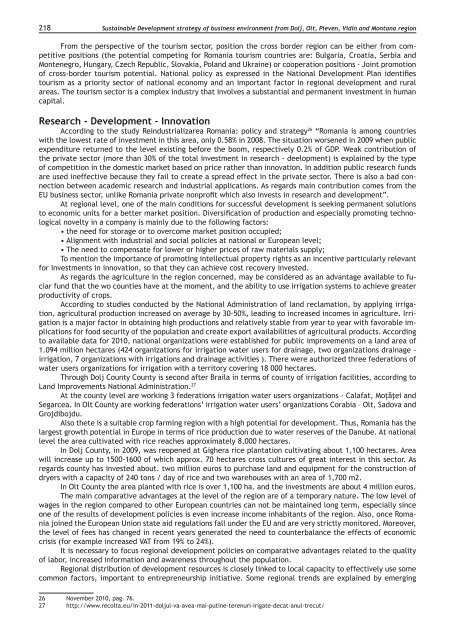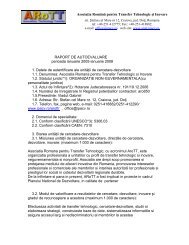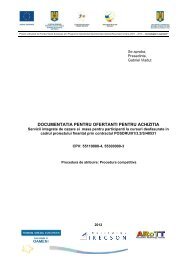You also want an ePaper? Increase the reach of your titles
YUMPU automatically turns print PDFs into web optimized ePapers that Google loves.
218Sustainable Development strategy of business envi<strong>ro</strong>nment f<strong>ro</strong>m Dolj, Olt, Pleven, Vidin and Montana regionF<strong>ro</strong>m the perspective of the tourism sector, position the c<strong>ro</strong>ss bor<st<strong>ro</strong>ng>de</st<strong>ro</strong>ng>r region can be either f<strong>ro</strong>m competitivepositions (the potential competing for Romania tourism countries are: Bulgaria, C<strong>ro</strong>atia, Serbia andMonteneg<strong>ro</strong>, Hungary, Czech Republic, Slovakia, Poland and Ukraine) or cooperation positions - Joint p<strong>ro</strong>motionof c<strong>ro</strong>ss-bor<st<strong>ro</strong>ng>de</st<strong>ro</strong>ng>r tourism potential. National policy as expressed in the National Development Plan i<st<strong>ro</strong>ng>de</st<strong>ro</strong>ng>ntifiestourism as a priority sector of national economy and an important factor in regional <st<strong>ro</strong>ng>de</st<strong>ro</strong>ng>velopment and ruralareas. The tourism sector is a complex industry that involves a substantial and permanent investment in humancapital.Research - Development - InnovationAccording to the study Reindustrializarea Romania: policy and strategy 26 “Romania is among countrieswith the lowest rate of investment in this area, only 0.58% in 2008. The situation worsened in 2009 when publicexpenditure returned to the level existing before the boom, respectively 0.2% of GDP. Weak contribution ofthe private sector (more than 30% of the total investment in research - <st<strong>ro</strong>ng>de</st<strong>ro</strong>ng>elopment) is explained by the typeof competition in the domestic market based on price rather than innovation. In addition public research fundsare used ineffective because they fail to create a spread effect in the private sector. There is also a bad connectionbetween aca<st<strong>ro</strong>ng>de</st<strong>ro</strong>ng>mic research and industrial applications. As regards main contribution comes f<strong>ro</strong>m theEU business sector, unlike Romania private nonp<strong>ro</strong>fit which also invests in research and <st<strong>ro</strong>ng>de</st<strong>ro</strong>ng>velopment”.At regional level, one of the main conditions for successful <st<strong>ro</strong>ng>de</st<strong>ro</strong>ng>velopment is seeking permanent solutionsto economic units for a better market position. Diversification of p<strong>ro</strong>duction and especially p<strong>ro</strong>moting technologicalnovelty in a company is mainly due to the following factors:• the need for storage or to overcome market position occupied;• Alignment with industrial and social policies at national or Eu<strong>ro</strong>pean level;• The need to compensate for lower or higher prices of raw materials supply;To mention the importance of p<strong>ro</strong>moting intellectual p<strong>ro</strong>perty rights as an incentive particularly relevantfor investments in innovation, so that they can achieve cost recovery invested.As regards the agriculture in the region concerned, may be consi<st<strong>ro</strong>ng>de</st<strong>ro</strong>ng>red as an advantage available to fuciarfund that the wo counties have at the moment, and the ability to use irrigation systems to achieve greaterp<strong>ro</strong>ductivity of c<strong>ro</strong>ps.According to studies conducted by the National Administration of land reclamation, by applying irrigation,agricultural p<strong>ro</strong>duction increased on average by 30-50%, leading to increased incomes in agriculture. Irrigationis a major factor in obtaining high p<strong>ro</strong>ductions and relatively stable f<strong>ro</strong>m year to year with favorable implicationsfor food security of the population and create export availabilities of agricultural p<strong>ro</strong>ducts. Accordingto available data for 2010, national organizations were established for public imp<strong>ro</strong>vements on a land area of 1.094 million hectares (424 organizations for irrigation water users for drainage, two organizations drainage -irrigation, 7 organizations with irrigations and drainage activities ). There were authorized three fe<st<strong>ro</strong>ng>de</st<strong>ro</strong>ng>rations ofwater users organizations for irrigation with a territory covering 18 000 hectares.Th<strong>ro</strong>ugh Dolj County County is second after Braila in terms of county of irrigation facilities, according toLand Imp<strong>ro</strong>vements National Administration. 27At the county level are working 3 fe<st<strong>ro</strong>ng>de</st<strong>ro</strong>ng>rations irrigation water users organizations - Calafat, Moţăţei andSegarcea. In Olt County are working fe<st<strong>ro</strong>ng>de</st<strong>ro</strong>ng>rations’ irrigation water users’ organizations Corabia – Olt, Sadova andG<strong>ro</strong>jdibojdu.Also thete is a suitable c<strong>ro</strong>p farming region with a high potential for <st<strong>ro</strong>ng>de</st<strong>ro</strong>ng>velopment. Thus, Romania has thelargest g<strong>ro</strong>wth potential in Eu<strong>ro</strong>pe in terms of rice p<strong>ro</strong>duction due to water reserves of the Danube. At nationallevel the area cultivated with rice reaches app<strong>ro</strong>ximately 8,000 hectares.In Dolj County, in 2009, was reopened at Gighera rice plantation cultivating about 1,100 hectares. Areawill increase up to 1500-1600 of which app<strong>ro</strong>x. 70 hectares c<strong>ro</strong>ss cultures of great interest in this sector. Asregards county has invested about. two million eu<strong>ro</strong>s to purchase land and equipment for the construction ofdryers with a capacity of 240 tons / day of rice and two warehouses with an area of 1,700 m2.In Olt County the area planted with rice is over 1,100 ha. and the investments are about 4 million eu<strong>ro</strong>s.The main comparative advantages at the level of the region are of a temporary nature. The low level ofwages in the region compared to other Eu<strong>ro</strong>pean countries can not be maintained long term, especially sinceone of the results of <st<strong>ro</strong>ng>de</st<strong>ro</strong>ng>velopment policies is even increase income inhabitants of the region. Also, once Romaniajoined the Eu<strong>ro</strong>pean Union state aid regulations fall un<st<strong>ro</strong>ng>de</st<strong>ro</strong>ng>r the EU and are very strictly monitored. Moreover,the level of fees has changed in recent years generated the need to counterbalance the effects of economiccrisis (for example increased VAT f<strong>ro</strong>m 19% to 24%).It is necessary to focus regional <st<strong>ro</strong>ng>de</st<strong>ro</strong>ng>velopment policies on comparative advantages related to the qualityof labor, increased information and awareness th<strong>ro</strong>ughout the population.Regional distribution of <st<strong>ro</strong>ng>de</st<strong>ro</strong>ng>velopment resources is closely linked to local capacity to effectively use somecommon factors, important to entrepreneurship initiative. Some regional trends are explained by emerging26 November 2010, pag. 76.27 http://www.recolta.eu/in-2011-doljul-va-avea-mai-putine-terenuri-irigate-<st<strong>ro</strong>ng>de</st<strong>ro</strong>ng>cat-anul-trecut/





